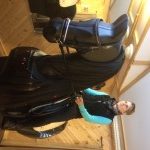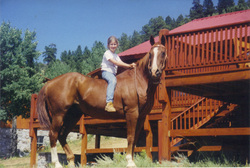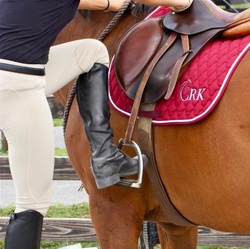A few weeks ago, I had the opportunity to try out a “riding simulator”, and not just any simulator but a super fancy technical one – the Racewood Dressage Model.
This is essentially a mechanical horse that walks, trots, canters, and even does flying lead changes!
The simulator gave me instant feedback on my balance, movement, rein pressure, even leg pressure. I practiced half halts and transitions, rode in a dressage arena and went for a nice canter along a dirt path through open fields… at least was the experience created by the screen in front of me!
Riding the simulator I learned something very interesting about my own riding…. Plus I discovered there are real benefits to working on a simulator like this. For example, imagine riding the canter while an instructor can stand right next to you the whole time, helping you find the best position and movement with your body!
Click play below to watch the video and learn more about my lesson on the simulator.
Learn more about the Riding Simulator: www.interactivehorsesimulator.com














26 Responses
I did ride the eventing simulator in March at Wellington, with Barbro Ask-Upmark teaching.
I had five lessons on the simulator, and it was amazing. I’m just a beginner, but I was still able to learn a lot about my balance, sitting trot, canter, flying lead changes, using the outside rein instead of the inside rein, transitions, as well as the difference between leg yield and half pass.
Barbro also teaches on the simulator at Tryon.
I wanted to ride the simulator to get my confidence back after a couple of nasty falls in the last year, and it was a great confidence builder for me.
Great to hear Susan, I’d love to try an eventing model sometime!
I have been thinking about riding the simulator that is at Tryon. I need to do it.
Hi Callie, thanks for another great video! About 5 years ago, I got the chance to try one of the newer model (at the time) of horse simulators. Riding a symmetrical “perfect” horse (no bucking or shying!) really helped me to focus on uncovering and then working on fixing my asymmetries and other riding problems I have. I really like the feedback on my weight in the saddle shown by the red circle: how centered or heavy I was. You don’t get that kind of feedback on a real horse. Better softer riders make for happier horses too. Back at home, you have clear issues you can work on. It was a bit pricey, but they had group discounts. Definitely worth it!
Back at home, you have clear issues you can work on. It was a bit pricey, but they had group discounts. Definitely worth it! 
I’m pretty sure my horse tries to give me this type of feedback, but I’m also pretty sure she’d give me a gift certificate to a mechanical horse if she could.
Haha!
My comment was a thumbs up emoji, but I guess it doesn’t take emojis!
Hi Callie,
I’m extremely lucky to have this exact riding simulator available to use at my riding school (apparently 1 of only 2 Grand Prix Racewood riding simulators in Australia and the only one in a riding school). I have used it on a number of occasions and found it a great help with learning and practicing the leg aids for the trot canter transition and I also found the constant readout on my hand pressure on the reins really helpful.
I’ve never had the opportunity to try one of these. I’ve seen other videos of them…don’t remember now which one, but I’d love to actually try one with an instructor to help. : )
hi callie,
my local riding school has one of these,its called radar!!
i was lucky enough to have a go on him a few months ago,its so much fun and really gets you to listen to your horse and body movements,and to really concentrate on what you are doing.They do hourly lessons on him and i think i may book some soon!!
i enjoyed it so much i even gave him a little pat on the neck when i got off lol!!
I would love to try one. where are you at. I am in the mid west so I can still not find one any were close to me
We have one of these at my local livery yard. I practice on it for about 20 minutes before I ride. It is excellent for isolating and working on different areas such as your seat, hands, leg position and so on, and then once you are in a good shape, with feedback from the mirrors and the training screen, you can get on the real horse and use the muscle memory to continue in good form. So far I have found it very useful for keeping my lower leg still in rising trot, for stopping myself tipping forward in canter transition and for keeping my hands low and soft. About once a month I have a half an hour lesson with an instructor where I practice light seat, working without stirrups and other things directed to areas where I need to develop. I am very lucky to have access to a simulator – if you ever get a chance to have a go it is very revealing about your hidden faults!
Fantastic to have one right at your barn!
Wow, the simulator that you were able to ride is very elaborate and looks so realistic. Several years ago, I had the chance to sit on a simulator that looked like the small back of the horse or like a saddle and it allowed you to feel the different gaits, walk, trot and canter, but that was it. At the time, I found it helpful to “feel” the canter. Your simulation experience looked wonderful and sounds like you got great feedback about your riding. As always Callie, thank you for sharing with us.
Nancy
That simulation machine screen would look like a large target impact zone for artillery if I were to ride it. Lol. But seriously my experience has been driving simulator. Once again you just don’t settle but you raise the bar! This is very valuable information I would had never known about a horse simulator! Awesome stuff young lady! Have a blessed day Callie!
Have a blessed day Callie!
Thank you Jimmie!
Hi Callie !! I have not ridden a simulator, but feel your description will help me in general while riding-to be much more aware of all- but especially my balance. I also wanted to thank you for sharing your Equitana experiences, especially with Linda Tellington – Jones, something I would never have the chance to do myself. Thank you for always being clear, concise and delivering your knowledge in such a caring and lovely way- you have helped me so much and I am so appreciative of the time you take. (and my beautiful horse thanks you also!! “). Ellen
Hi Callie,
Last year, I had an amazing lesson on an identical simulator (called Blackberry!). This was at Arrow Equestrian in the UK. My instructor was the lovely Sue-Nevill Parker – who like you, is also a biomechanics / Feldenkrais practitioner.
I found the simulator to be an amazing help, as it transpired that during canter I had fallen into the trap that you’ve mentioned many times (pushing the heels down – instead of letting them ‘hang’) As a result, I was bouncy due to much of my weight being through my legs instead of the seat.
What other way could there be, where an instructor can adjust your position during a fast canter? And the whole time there were camera views of all 4 sides, so that I could adjust my body to the ideal centre line.
My lesson culminated in a lunge lesson on one of Sue’s horses (without reins or saddle, but luckily a comfy blanket to sit on) The point of this was to really establish the canter seat, and feel what the horse is doing. In the end I was circling around in canter with my hands raised, with a stupid grin on my face!
I would heartily recommend trying a simulator to a rider of any level. I had to travel some distance for my lesson, but it was definitely worth it.
Mark
Hi Mark, what a great way to learn transitioning from the simulator to the lunge lesson!
I’ve had a few lessons on simulator… in fact the exact one that Callie uses in the video from Roozaro Farm. The lessons on the simulator for me were so very helpful since it is a “perfect” horse and all the lesson time can be focused on the rider. There is no arena atmosphere space/distance, speed, navigation, no horse who is tired or unbalanced and no weather issues to confuse things. You can also repeat things and concentrate on problem areas without a horse becoming frustrated or tired. It really helped me with practicing transitions of gaits over and over again and to develop a deeper awareness of my balance and seat. It really helped having Susan Jones as the coach for the simulator. She was not only knowledgeable in biomechanics and Feldenkrais but she was really involved in my entire session. She didn’t let the simulator educate alone but used it as a tool. She was an integral part of the learning process and the entire experience. So I feel that the coach for the simulator would make a big difference in someone’s experience on a simulator and what they learn from it.
Are these available in WA? How do you find out where they are made available? This would be perfect for those of us that have had a horse related accident, it would help to overcome some of the fear, and ptsd that comes with a bad accident.
Hi Christine, here is a list from the manufacturer of the simulator I rode. http://www.racewood.com/our-customers.php
Callie, what a neat experience to ride that mechanical horse!
I own one called an Equicizer. It’s custom made to look like your own favorite horse and it can be used for Exercise, Training, and Therapeutic Riding. Frank Lovato (a jockey) started up his “Wooden Horse Corporation” after he was pretty seriously injured racing…so for aiding his rehab he came up with a mechanical horse he could ride both for exercise and for strengthening core and legs and maintain correct position and balance. He eventually began manufacturing them, making them available to the public. Riding instructors, like myself, are using them for teaching students correct position, balance, and riding in rhythm while keeping a light following feel on the reins. It’s not nearly as sophisticated as the one you are riding and demonstrating. Mine has a “canter” gait which can be used for teaching how to ride the canter/gallop, or for practicing a 2 point position. I can post on it as well, but it’s more difficult because the horse only gives you a forward and back motion….it does, however, give the rider a good workout which can get you back in shape if you’ve taken the winter off or just haven’t ridden much and want to strengthen your core, improve your balance and riding position. I love my “Morraya” equicizer… I don’t need to feed her, trim hooves, or pick up poop! And she can be indoors. But, of course, she doesn’t communicate back to me or have that “wonderful horse smell!”
Hello: that was great, have not had the opportunity to try one of these. Having just gone back to riding at 61 yrs of age, wish I could afford one of these for home. Am riding once per week (dont have my own horse) as well as trail rides. This is a great idea, thanks for the information. Lynda.
I had one session – just one! – on a mechanical horse similar to this one, and I learnt three things which I’d never really managed to grasp, even though I’d been riding for about 40 years.
First was how to brace my back to signal to a horse that I wanted a downward transition – either from one pace to another, or from one pace to halt. And why it was so easy was because, as you point out, the instructor was standing right next to me, even though I was cantering! So she was able to put the flat of her hand on my back, and say “Brace THESE muscles, NOW!” It worked a treat. In fact, it worked so well that instead of going from a sitting trot to a walk, I went from a sitting trot to a halt! (how the mechanical horse can sense this back bracing, I’ve no idea – but it can and does).
The other discovery was why did I lift out of the saddle when trying for an upward transition (particularly to a canter), and why did I feel that the stirrup bars were ALWAYS too far forward, making it difficult for me to apply my lower leg to the horse’s flank without losing a stirrup. The instructor got me going, looked very closely at my knee position (from about 6 inches away!), and said:
“You were taught by people who learnt to ride in the 1950s, weren’t you?”
“Yes,” I said, “how does it show?”
“Hands as light as a feather, and a vice-like grip with the knees!”, she replied.
Then she slid her fingertips in between my knee and the saddle, looked me right in the eye, and said:
“Now – you aren’t going to squash my fingers, are you, Jack?”
“No, Lisa.”
She started Rocky going again, with her fingertips tucked in, and I found my backside was just resting in the saddle with no effort, and my lower leg was wrapped round the horse’s flank in light contact with it. Basically, that tight knee grip had locked up the whole of my leg – and all it took to cure it was to relax my knees, and move them no more than half an inch away from the saddle!
It was the same when I did a transition from a trot to canter; my backside was as steady in the saddle as though I was sitting on a chair – and my legs were free to work independently of my body, and give the horse a gentle nudge with my heel . . . as easy as that.
As for the long term effect; the following week, I went back to my usual riding school, having another lesson with my (first rate) instructor, who noticed that I was getting the horse to respond to my leg aids, even though my legs didn’t appear to be moving at all.
After the lesson was over, one of the other instructors said she’d been walking past the school while I was having my lesson, and wanted to know what I’d done, as she said “I’ve NEVER seen a horse work like that for you before!”
The best £25 I’ve ever spent!!